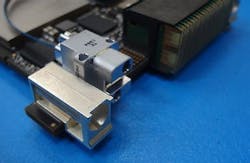Embedded computing community seeks to push I/O speeds in exploring new frontier of optical interconnects
Not only does the use of fiber interconnects offer the potential to add speed to system I/O, but it also can help optical embedded computing systems designers increase the distance between computing nodes and reduce size and weight, says Matthew McAlonis, product development engineering manager at interconnect expert TE Connectivity in Middletown, Pa.
A fiber optical backplane even can be layed out on sheets of lightweight Mylar sheets to help save space and reduce weight in HPEC systems with optical interconnects, McAlonis says.
Some of the most promising applications of optical computing include remote radio receivers, which could couple digital signal-processing subsystems near the antenna mast on a ship, and move signals over optical fiber to radio control rooms deep inside the vessel, says Rodger Hosking, vice president at embedded computing specialist Pentek Inc. in Upper Saddle River N.J.
Related: The future of high-performance embedded computing
Pentek is one of the first mainstream embedded computing companies to make use of optical interconnects in off-the-shelf products. McAlonis and Hosking made their comments in presentations this week at the Embedded Tech Trends conference in Phoenix.
Optical interconnects have several advantages compared to the copper interconnects they are being designed to replace: they are faster, more lightweight, and are impervious to electronic interference. Still, there are tradeoffs. Copper arguably is more reliable than fiber, is well known, and has a large installed base.
"Fiber optic technology still has its challenges, but steady progress has led to rapidly expanding deployment," says Greg Powers, market development manager at TE Connectivity.
Another potential problem with optical fiber is it tends to break if pulled too hard or curved too tightly inside systems. Higher costs, reliability concerns, and higher complexity when compared to copper will give systems designers pause.
TE Connectivity engineers are working on an optical interconnect approach for embedded computing that involves magnifying lenses where lengths of optical fiber join. The lens physically separates the fiber ends to help resist the effects of shock and vibration, as well as mitigate the effects of contamination.
Despite fiber's drawbacks, its potential benefits are great, and the VITA Open Standards and Open Markets embedded systems industry trade group in Fountain Hills, Ariz., is pushing forward with optical interconnect standards. The group's VITA 66.4 standard defines optical backplane interfaces for VPX cards, and companies like Pentek have implemented optical interconnects in HPEC systems.
While optical connects offer tremendous increases in data throughput speeds, this technology is not for everyone, experts acknowledge. Large, demanding new HPEC systems are the most likely candidates for optical interconnects, while small, inexpensive, and routine applications most likely will stay with copper, experts say.
For more information contact TE Connectivity online at www.te.com, Pentek at www.pentek.com, the Embedded Tech Trends conference at www.embeddedtechtrends.com, or the VITA trade organization at www.vita.com.
